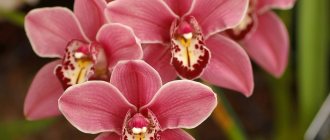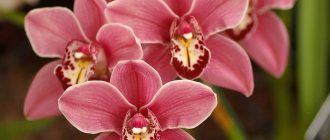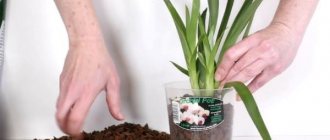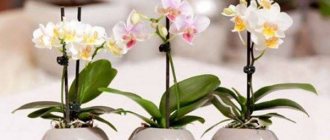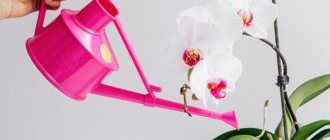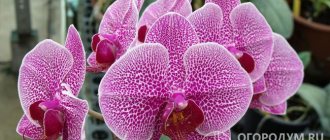Orchids have been occupying a leading position in the ranking of the popularity of indoor plants for several years now. This is the most “giftable” plant. Therefore, an orchid often falls under the care of a person who is very far from floriculture and has very vague ideas about how to grow it correctly. With careful and proper care, an orchid can grow at home and delight us for many years. This care is simple and not burdensome. Minor deviations from the rules of care do not cause significant harm to the plant. But, alas, as sad statistics show, almost half of donated orchids die after the first flowering. The reasons for this are different, but they are all a consequence of ignorance of the rules of care or careless implementation of them. The absolute leader among these violations belongs to improper watering.
When and how often to water orchids
First, let me clarify. Among orchids there is also a clear leader - phalaenopsis. This is what is most often given as a gift. More exotic Miltonias, Cambrias, Dendrobiums, Cymbidiums, Paphiopedilums and others are significantly inferior to Phalaenopsis in terms of “purchasability and giftability”. Therefore, we will consider the rules for watering orchids using his example. First of all, it should be noted that the frequency of watering orchids at home will depend on factors such as air temperature, humidity, substrate composition, pot volume, life cycle and time of year. External primary signs of the need to water orchids are:
- The roots of the plant have become pale green or white. With normal watering they should be green.
- The walls of the pot are dry. If there are even the smallest drops of moisture on them, they should not be watered.
- The orchid pot is very light.
- You can carefully lower a dry stick into the pot and check the humidity in its depths.
- With prolonged drying, orchid leaves wither and turn yellow.
Note! Dry pieces of bark on the surface of the pot are not a reason for the next watering. The frequency of watering also depends on the time of year. Usually, orchids are watered once a week in summer, and in winter, during the dormant period and in preparation for flowering, no more than twice a month.
Useful tips and tricks
Orchids are very difficult plants to care for. One wrong step can destroy the flower once and for all. Beginning gardeners make a lot of mistakes. To prevent this, consider below some useful tips:
- Overfilling is the most common mistake that should be avoided.
The roots of the flower do not tolerate moisture well, which leads to their rotting. Advice! This can be avoided by using high polystyrene foam drainage - about 4 cm. - When watering, try not to get into the axils of the leaves, otherwise this may lead to rotting of the root collar of the plant and it will die.
- You need to spray the flower from a distance of at least 20 cm. If you do not maintain this distance, the liquid will take longer to evaporate.
- The orchid should only be irrigated with high-quality, boiled water at room temperature. Hard cold water will quickly cause the root system of the plant to die.
- When using the immersion method, it is necessary to change the water after each pot. This is done so that if one plant becomes sick, it does not infect the others.
By following all these simple rules, you can get a healthy flower that will delight the eyes of its owner and his guests.
Watering orchids varies in their application and characteristics. Now that you know how to water this plant correctly, nothing will stop you from growing it at home.
Water for watering orchids
For regular watering, you cannot use water taken directly from the tap. At a minimum, it should be defended. But this is not enough. Ideally, water for watering an orchid should be boiled or passed through a filter. The presence of salts, iron and chlorine compounds in its composition is extremely undesirable. You can soften the water and make it more suitable for irrigation using peat. To do this, you need to take a handful of high-moor (sour) peat, wrap it in a napkin and put it in a container of water (about 3 liters) for 10-12 hours. Oxalic acid is also used to soften water. Note! Water for watering orchids must be warm.
Watering orchids at home - methods
Dive
The most effective and common method. If possible, purchase a special container for watering orchids that matches the size of your plant's pot. In fact, this is the same pot, but without drainage holes. When using it, you will avoid floating and overturning the pot with the plant. In the absence of such a container, you can use any other container of a suitable size. The pot with the orchid is lowered into it so that the water level is one centimeter below the top edge of the pot. Usually 10-15 minutes are enough for the substrate to become saturated with moisture. A sign of this will be the appearance of moisture on its upper layer. After this, the pot must be removed from the water and all moisture allowed to drain. During such watering, you can also feed the orchids by dissolving fertilizer in the water.
Top watering (using a watering can)
This method is also used. But you should be careful when using it. Do not allow water to get into the axils of the leaves. Its accumulation can cause rotting of the orchid leaf. For watering, it is better to use a watering can with a long thin spout. Watering is carried out in several stages. Water flows until it begins to flow through the drainage holes. Then a break for a couple of minutes, and the procedure is repeated. And so 3-4 times. Drain the water that has flowed into the pan.
Watering with running water (warm shower)
This is the case when watering from the tap is allowed. But only if this method is not permanent, but is used only occasionally. Otherwise, use a garden watering can. This method of watering orchids is closest to natural, as it imitates rain. In addition to moistening the substrate and the roots of the plant, dust, possible pests and other nasties are washed off from the leaves. It also stimulates foliage growth. Watering is best done in a bathtub, but you can put a pot with a plant in a basin if you water it with a watering can. Water for irrigation should be warm, sometimes even hot water of 40-50 degrees is used. Watering the orchid continues until the substrate is saturated with moisture. After this, the water from the pot is allowed to drain and the orchid is left in a shaded place for 30-40 minutes. Then you should definitely wipe the leaves with a dry cloth, but the main thing is to remove all moisture from the axils of the leaves.
Spraying the roots
This method is unlikely to be useful to novice gardeners. It is used for orchids that are grown openly, without the use of a substrate. In this case, a spray bottle with a very fine spray of water is used. With its help, the roots of the orchid, fixed to the supporting surface, are abundantly irrigated.
Basic mistakes
Photo: Points after water gets on the inflorescences
Most often, mistakes when watering are made due to inexperience or ignorance, therefore, to avoid the death of a flower, you need to follow the rules:
- You can't overwater a flower. Overwatering leads to rotting of the roots and gradual death of the plant.
- It is necessary to avoid getting water into the inflorescences and leaf axils, as this also leads to rotting of the flower.
- You need to use only high-quality water, because a lot depends on its softness and composition. Also, do not use dirty or hard water.
- After or during exposure to direct sunlight, the orchid cannot be sprayed, as this can lead to sunburn. It is better not to spray the orchid at all, but to increase the air humidity in other ways, if necessary.
- In winter, excessive watering and spraying lead to the creation of conditions for the occurrence of diseases.
Watering orchids after purchase
This point deserves special attention. The fact is that in most cases, phalaenopsis, which are sold in flower shops, have a specific soil composition. In addition to the obligatory bark and sphagnum moss, they may contain anything that helps give and maintain the plant’s marketable appearance. We understand that the main thing for a merchant is to sell, and what happens next is our headache. Most often, in the composition of the substrate you can find some kind of moisture accumulators, called among gardeners “sponges”, “washcloths”, “sponges”, which, in fact, are what they are. These are pieces of synthetic material that absorbs a large amount of water and allows you not to water the orchid for a long time, which is important during transportation and mass storage. There's nothing particularly scary about this. The material is synthetic, therefore, does not rot or decompose. But its danger lies in the fact that the watering schedule in this case changes radically. It is very difficult to determine the absence or presence of moisture in such a “battery”. And their very presence may raise doubts. Conscientious sellers always warn that the substrate contains a sponge. Otherwise, it may turn out to be an unpleasant surprise. Experienced gardeners, after purchasing any plants and after two weeks of quarantine, replant them in fresh soil. But not every amateur can do this, and it is not advisable to do this during flowering. Therefore, when purchasing, be sure to ask the seller about the presence of such surprises. And if they are, then all watering before replanting the orchid should be carried out less than once and a half to two times. In any case, after purchasing, place the orchid separately from other plants (if any) and quarantine for 7-10 days. There is no need to water at this time. Then you can start watering. I recommend doing the first watering with boiled or distilled water. It is better to use the immersion method. And repeat it several times, changing the water. This will wash away unnecessary salts from the soil. Of course, the fertilizers with which manufacturers and sellers fertilized them will also go away. But you don't need them. Usually, these are very strong stimulants that deplete the plant. It is better to buy high-quality fertilizer and use it.
That's all the basic rules for watering orchids. But, there will also be a considerable number of nuances that will be specific to your plant, and here everything will depend on you. Try different methods and decide which one is best for you and your plant. Observe the plant and substrate. It won't be long before you can accurately determine when and how to water your orchids.
How to water orchids - video
There is a special method for growing orchids in water. To do this, you need to have a glass vase with transparent walls and the necessary knowledge for cultivating the plant using hydroponics.
Next, we will tell you whether and how long it is possible to keep an orchid in water for the benefit of the plant.
Moisture requirements during flowering
With the beginning of the growing season, orchids' need for moisture increases. Preparing to bloom, the plant begins to require increased nutrition. Watering orchids during flowering is different from watering at other times of the year. A flowering plant is watered under the roots, without touching the leaves and flowers. If the humidity in the room is low, you can carefully spray the leaves of the plant, trying not to get on the flower itself. But the general rules do not apply to all orchids.
How to water an orchid during flowering depends on its type. Vanda needs to be “set sailing”, making sure that the flowers do not get wet. Phalaenopsis, paphiopedilum and dendrobiums love to “swim”. Cymbidium should never be soaked. Like Camriya, it prefers moderate watering, and you can keep the substrate moist by covering the top of the soil with moss. Cattleya doesn't like water at all. It is difficult to know how often to water this orchid and you have to rely on the condition of the substrate. Water the cattleya after the soil in the pot has completely dried.
With experience comes skill and understanding of how often a particular orchid needs to be watered, and this issue no longer causes difficulties for experienced orchid growers. In addition, with increasing experience, it turns out that caring for orchids is not as complicated as it may seem to novice orchid growers.
General provisions
Epiphytes - what are they and how do they grow in nature?
In nature, this exotic beauty grows on trees. But the flower is not a parasite, since it takes food for its development from the air and dead tree bark , which may be located in a crevice or other recess.
In this regard, the orchid belongs to the group of epiphytic plants growing on trees.
The structure of orchid roots
The roots of the plant consist of:
- Conductive thread;
- Parenchyma;
- Velamena;
- Apical tip of the root.
All parts are involved in photosynthesis of the plant and are vital for proper metabolism. With frequent watering, the velamen and parenchyma rot, exposing the root to a conductive thread. Therefore, drying of the flower is required.
Orchid root: 1 - Central cylinder; 2 - Epiblema; 3 - Velamen.
Basic rules of watering
When cultivating a plant, it is important to choose the right watering regime and water quality. Here are the basic rules for watering:
- Water the flower when the roots turn whitish or light gray. Green roots do not need watering;
- The bark should dry 2/3 of the container;
- The water used for irrigation should be warm, settled and soft. Water hardness can be reduced by boiling.
Sprinkling
You can bathe the plant in the shower - this is very useful . As a result, good leaves will grow and larger flowers will bloom.
Method of how to bathe an orchid using a shower to simulate rain:
- the plants are placed in the bathtub and watered with low pressure from the shower, but the water should be soft and warm 30-40 degrees ;
- imitate rain until the bark is completely wet, after which the flowers are left there so that the water completely drains from the substrate. There is no point in spraying water on the flowers ;
- after an hour, you need to wipe the sinuses of the leaf plates so that moisture does not accumulate there, which can lead to rotting of the leaf and its death. Especially the removal of moisture concerns such plant species as Phalaenopsis and Vanda.
Immersion method
Also very often, gardeners use immersion watering. This is used in most regions of Russia, because the water flowing from the tap is quite hard.
The main rules for how and how much to immerse orchids in water:
- water is prepared according to the parameters in advance;
- the container where the plant will be immersed must be of such a size that the immersed pot with a flower can wet its entire bark;
- immerse the container slowly so that the dry bark cannot push the roots of the flower into the air;
- The length of time plants should stand in water depends on the size of the root mass. Typically the dive lasts from 10 to 25 minutes ;
- After the watering procedure, you must allow the water to drain completely and only then place the container with the flower on the tray.
Common mistakes when watering
Neglecting simple rules in caring for orchids will lead to plant disease and its inevitable death.
Excessive watering and the absence of periods when the roots of the plant dry completely are the causes of rotting of the orchid roots, as well as the rosette of leaves.
If after watering you do not remove excess moisture from the leaves and expose the orchid to the sun, light spots will appear on the leaves - sunburn. It is better to cut off leaves with defects immediately.
When spraying an orchid, the sprayer should be placed at a distance of 20 cm from the flower. Large drops can cause dark spots to appear on the leaves and also destroy blooming flowers.
The essence of the method
In order for a plant to constantly delight with its flowers, it does not need ordinary water, but a specially fertilized liquid. All substances that are added to water are determined strictly according to proportions; only this can ensure uniform nutrition of the flower.
Options for the soilless method:
- hydroponics – the plant is grown in water;
- aeroponics – the flower develops in the air;
- hydroculture - substrate is added to the growing liquid.
Growing an orchid in water is not particularly difficult; this is dictated by the natural needs of the flower. Initially, it does not require soil, which is why the option of water cultivation appeared. This method has many advantages, but there are also disadvantages.
Hydroponic care
It is important to understand that the main function of the orchid root system is to secure the flower in a vertical position and synthesize hydrocarbons, which are obtained as a result of photosynthesis. The substrate must allow the root system to perform its functions, in some ways even activating them.
Therefore, orchids growing on hydrogel should be planted in a transparent pot and provided with the necessary daylight hours in the same way as if the orchid was growing in a regular substrate. Hydroponics involves keeping plants in a nutrient solution.
Advantages and disadvantages
Soil cultivation is inferior to hydroponics and hydroculture in some respects.
Benefits of growing without soil.
- The absence of rot and parasites in the soil (an important point). Orchid roots are initially susceptible to rotting processes. But if you cultivate hydroponically, there will be a large amount of oxygen in the water, and regular changes of liquid will also prevent rotting.
- There is no need for regular replanting , as is the case with soil growth.
- The flower is not subjected to excessive feeding load.
- The water is constantly enriched with nutrients, so the flowers grow strong and healthy.
- The roots do not dry out due to oxygen deficiency.
But the disadvantages will also have to be mentioned. Thus, the water method requires constant monitoring of the water temperature - it must remain cool. The grower is also forced to ensure that the water limit marker does not fall below the beginning root system. If this happens, the fluid needs to be added.
Feeding should be done throughout the entire growth period. This means that care requires regularity.
Aqua soils and hydrogels
Aqua soil is a polymer synthetic material produced in various configurations: it is intended for decorating flowerpots, soils, aquariums or garden plantings.
Aqua soil is not recommended for use as a substrate for plants, especially for plants as fragile as orchids.
Hydrogel is a high-tech structure created artificially as a result of many years of research and testing conducted by the best physicists, chemists, technologists and agronomists.
The hydrogel is capable of absorbing an amount of water hundreds of times greater than its weight, after which it gradually releases this liquid to the plant. At the same time, it does not create conditions for the development of pathogenic microorganisms, does not acidify the environment, and does not release substances harmful to plants.
Growing technology
It is not recommended to grow orchids in aqua soil , because the substance from which it consists does not perform the functions that are superimposed on the hydrogel. Moreover, if the necessary action is not taken, aquagel can harm the flower.
A hydrogel capable of absorbing large amounts of liquid without creating uncomfortable conditions for the maintenance of the plant’s root system, but releasing it to the extent that the flower needs it.
The hydrogel is placed in water, left to absorb it in the required amount, then the swollen mass is placed in a container prepared in advance, in which the root system is placed. Sometimes hydrogel is combined with expanded clay, which serves to secure the roots.
Orchids in hydrogel.
Transfer to water from soil
The plant needs to be adapted to the newly created conditions.
For this:
- remove the flower from the soil, clean its roots from adhering elements;
- then it is supposed to be immersed in water for about a third of the length of the roots for 2 days, after which the water is poured out and allowed to dry;
- after a week, the time for water procedures will increase to 5 days + one day for rest (it is important to let the roots dry);
- after which the roots must be kept in water all the time, and do not forget to regularly change the water, rinse the roots more often;
- Whether the flower still needs water will be clear from the condition of the roots - they will turn silver.
This period marks the intensive growth of young roots, while faded green sprouts appear on old roots. If you see mold or a whitish coating, remove the plant from the pot for a day. Then clean its roots with hydrogen peroxide or a fungicidal compound.
But green algae on the roots should not be removed; they improve the air exchange of the flower.
About the substrate
As already noted, hydroculture is the use of a substrate, and hydroponics is only water. Many gardeners prefer the first option, considering it aesthetically more attractive. How much substrate is needed depends on its type.
How to fill the substrate:
- diatomaceous earth should be alternated with expanded clay, filling it up to the beginning of the holes;
- expanded clay as a monocomposition should be filled to the middle, then a flower is placed, and the substrate is added again;
- if you decide to use perlite, then the bottom is first covered with an expanded clay layer, then the flower is placed, and perlite is added to a distance of 1 cm from the holes;
- The greenmix is filled up, watered up to the drainage holes, after which the plant mixture is poured.
An orchid in a pot with a substrate should stand confidently.
By choosing a bulk product, you can interestingly play up the image of a flower: enhance its tenderness or play with contrast.
The basic rule is constant monitoring of water levels. But other advice should not be ignored either.
Rules of care:
- the temperature in the room in winter cannot be below 25 degrees;
- to create flower buds, you need to organize a preparatory period of two weeks, during which time the temperature should be below 15 degrees;
- good air humidity - no more than 75%, it is fundamentally important to observe this criterion during the period of growth of rosettes, which is helped by growing in water, because evaporated moisture increases air humidity;
- a flowerpot with a flower is placed away from drafts, in summer - on the balcony so that direct rays of the sun do not injure it;
- rainwater is used for topping up; alternatively, water filtered through charcoal (this is important for softness);
- the leaves of the orchid should not touch the water - this precedes rotting, and if drops fall on the leaves during watering, they are removed with a soft cloth or napkin;
- from time to time inspect and clean the holes in the flowerpots;
- replace the solution every 3 days;
- Rinse the pot monthly, the roots need to be wiped and dried for 6 minutes, then immersed in the solution again.
The container for growing is preferably transparent. Glass vases may seem like an attractive option, but they won't be useful. Still, this material is cold, and it is almost impossible to make normal holes in it. Therefore, flower growers choose plastic flowerpots, which are sold in flower shops everywhere.
There must be holes for air exchange in the flowerpot.
What happened to the orchid
Let me start with the fact that the orchid came into the house from a cold street. I suspect she might have frozen on the way. And also, before seriously taking it up, I kept the flower along with all the gifts in the corridor of day 3.
Therefore, when hands finally got around to the orchid, it looked rather damaged. The flowers have fallen, one leaf has begun to turn yellow. At first I wanted to throw it away, but my mother-in-law stopped me. We transplanted the flower into a mixture of bark, charcoal and sphagnum.
After replanting, I watered the flower occasionally. I found on the Internet that too much water is also bad for him. The more time passed, the worse the orchid looked. I cut off the peduncle, leaving only a couple of centimeters of the trunk.
The central leaf continued to turn yellow. He did this from the edge in an even strip. As they say, slowly but surely. But the rest of the leaves seemed to remain normal. My mother-in-law advised me to be patient and place the plant on a southwest window.
About tap water
It is not very correct to place a flower in tap water. There is a high probability that the roots will begin to rot. This method is used strictly to strengthen and propagate roots. There is only one variety that can easily tolerate tap water - “Vanda”. By the way, it can also be grown in a glass vase.
If you decide to keep a flower in a vase, constantly change the water and keep the temperature constant.
Sometimes let the orchid roots dry out between waterings.
Possible difficulties and solutions to them
As with any other indoor flower, the following difficulties may arise in the process of growing orchids:
- Wrinkled edges of the leaves of the flower, which indicate that the temperature in the room is too high. The difference between day and night ambient temperatures should be about 8 ºС.
- If the root system of the plant rots or dries out, this indicates excessive watering or a very cramped pot that squeezes the roots of the crop. Another reason for this state of the flower is considered to be rich watering after a dry period.
- There is no flowering for a long time. Try to give your orchid heat stress. This means that the temperature difference between day and night should be a difference of 8-10 ºС.

